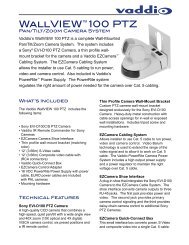AXIS 231D+/232D+ Network Dome Camera User's Manual
AXIS 231D+/232D+ Network Dome Camera User's Manual
AXIS 231D+/232D+ Network Dome Camera User's Manual
Create successful ePaper yourself
Turn your PDF publications into a flip-book with our unique Google optimized e-Paper software.
64 <strong>AXIS</strong> <strong>231D+</strong>/<strong>232D+</strong> - Glossary of Termsinterconnection is known as a virtual private network(VPN).Pre/post alarm images - The images from immediatelybefore and after an alarm. These images are stored in abuffer for later retrieval.Progressive scan - Progressive scan, as opposed tointerlaced video, scans the entire picture, line by line everysixteenth of a second. In other words, captured images arenot split into separate fields as in interlaced scanning.Computer monitors do not need interlace to show thepicture on the screen, but instead show them progressively,on one line at a time in perfect order, i.e. 1, 2, 3, 4, 5, 6, 7and so on; so there is virtually no "flickering" effect. In asurveillance application, this can be critical when viewingdetail within a moving image, such as a person running. Ahigh-quality monitor is required to get the best fromprogressive scan. See also Interlacing.Protocol - A special set of rules governing how two entitieswill communicate. Protocols are found at many levels ofcommunication, and there are hardware protocols andsoftware protocols.Proxy server - In an organization that uses the Internet, aproxy server acts as an intermediary between a workstationuser and the Internet. This provides security, administrativecontrol, and a caching service. Any proxy server associatedwith a gateway server, or part of a gateway server,effectively separates the organization’s network from theoutside network and the local firewall. It is the firewallserver that protects the network against outside intrusion.A proxy server receives requests for Internet services (suchas web page requests) from many users. If the proxy serveris also a cache server, it looks in its local cache ofpreviously downloaded web pages. If it finds the page, it isreturned to the user without forwarding the request to theInternet. If the page is not in the cache, the proxy server,acting as a client on behalf of the user, uses one of its ownIP addresses to request the page from another server overthe Internet. When the requested page is returned, the proxyserver forwards it to the user that originally requested it.P-VOP - See VOP.Resolution - Image resolution is a measure of how muchdetail a digital image can hold: the greater the resolution,the greater the level of detail. Resolution can be specified asthe number of pixel-columns (width) by the number ofpixel-rows (height), e.g. 320x240.Alternatively, the total number of pixels (usually inmegapixels) in the image can be used. In analog systems itis also common to use other format designations, such asCIF, QCIF, and 4CIF.RTCP (Real-Time Control Protocol) - RTCP providessupport for real-time conferencing of groups of any sizewithin an intranet. This support includes sourceidentification and support for gateways like audio and videobridges as well as multicast-to-unicast translators.RTCP offers quality-of-service feedback from receivers tothe multicast group as well as support for thesynchronization of different media streams.RTP (Real-Time Transport Protocol) - RTP is an Internetprotocol for the transport of real-time data, e.g. audio andvideo. It can be used for media-on-demand as well asinteractive services such as Internet telephony.RTSP (Real Time Streaming Protocol) - RTSP is a controlprotocol, and a starting point for negotiating transportssuch as RTP, multicast and Unicast, and for negotiatingcodecs.RTSP can be considered a "remote control" for controllingthe media stream delivered by a media server. RTSP serverstypically use RTP as the protocol for the actual transport ofaudio/video data.Router - A device that determines the next network point towhich a packet should be forwarded on its way to its finaldestination. A router creates and/or maintains a specialrouting table that stores information on how best to reachcertain destinations. A router is sometimes included as partof a network switch. See also switch.Server - In general, a server is a computer program thatprovides services to other computer programs in the same orother computers. A computer running a server program isalso frequently referred to as a server. In practice, the servermay contain any number of server and client programs. Aweb server is the computer program that supplies therequested HTML pages or files to the client (browser).Sharpness - This is the control of fine detail within apicture. This feature was originally introduced into color TVsets that used notch filter decoders. This filter took away allhigh frequency detail in the black and white region of thepicture. The sharpness control attempted to put some of thatdetail back in the picture. Sharpness controls are mostlysuperfluous in today's high-end TVs. The only logicalrequirement for it nowadays is on a VHS machine.Simplex - In simplex operation, a network cable orcommunications channel can only send information in onedirection.SMTP (Simple Mail Transfer Protocol) - SMTP is used forsending and receiving e-mail. However, as it is "simple," itis limited in its ability to queue messages at the receivingend, and is usually used with one of two other protocols,POP3 or IMAP. These other protocols allow the user to savemessages in a server mailbox and download themperiodically from the server.SMTP authentication is an extension of SMTP, whereby theclient is required to log into the mail server before or duringthe sending of email. It can be used to allow legitimate usersto send email while denying the service to unauthorizedusers, such as spammers.SNMP (Simple <strong>Network</strong> Management Protocol) - SNMP
















